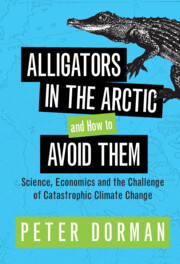 Alligators in the Arctic and How to Avoid Them
Alligators in the Arctic and How to Avoid Them Published online by Cambridge University Press: 14 July 2022
Climate change presents two types of risks: those we can adapt to or try to counteract and those beyond our power to cope. The first group includes (1) sea level rise, which threatens much of our infrastructure and cultural patrimony; (2) extreme weather, particularly storm events; (3) climate alterations harmful to agriculture; (4) loss of biodiversity; (5) ocean acidification that interferes with shell production and threatens marine food chains; and (6) threats to human health from disease and especially extreme heat. The second group, which encompasses an unmanageable intensification of all of the first, is the risk of runaway climate change. This can arise if elevated atmospheric carbon concentrations trigger positive feedback mechanisms, like stored methane releases, widespread forest die-offs, reduction of the Earth’s albedo, or changes in prevalent cloud formations that amplify initial warming effects, resulting in a “hothouse Earth.” The tools of standard welfare economics, like calculation of a social cost of carbon and its use in cost–benefit analysis, are unhelpful. Their basis in marginal effects is contradicted by the scale of climate impacts, and their deference to consumer judgment tells us little about the political judgments that must guide policy trade-offs.
To save this book to your Kindle, first ensure [email protected] is added to your Approved Personal Document E-mail List under your Personal Document Settings on the Manage Your Content and Devices page of your Amazon account. Then enter the ‘name’ part of your Kindle email address below. Find out more about saving to your Kindle.
Note you can select to save to either the @free.kindle.com or @kindle.com variations. ‘@free.kindle.com’ emails are free but can only be saved to your device when it is connected to wi-fi. ‘@kindle.com’ emails can be delivered even when you are not connected to wi-fi, but note that service fees apply.
Find out more about the Kindle Personal Document Service.
To save content items to your account, please confirm that you agree to abide by our usage policies. If this is the first time you use this feature, you will be asked to authorise Cambridge Core to connect with your account. Find out more about saving content to Dropbox.
To save content items to your account, please confirm that you agree to abide by our usage policies. If this is the first time you use this feature, you will be asked to authorise Cambridge Core to connect with your account. Find out more about saving content to Google Drive.